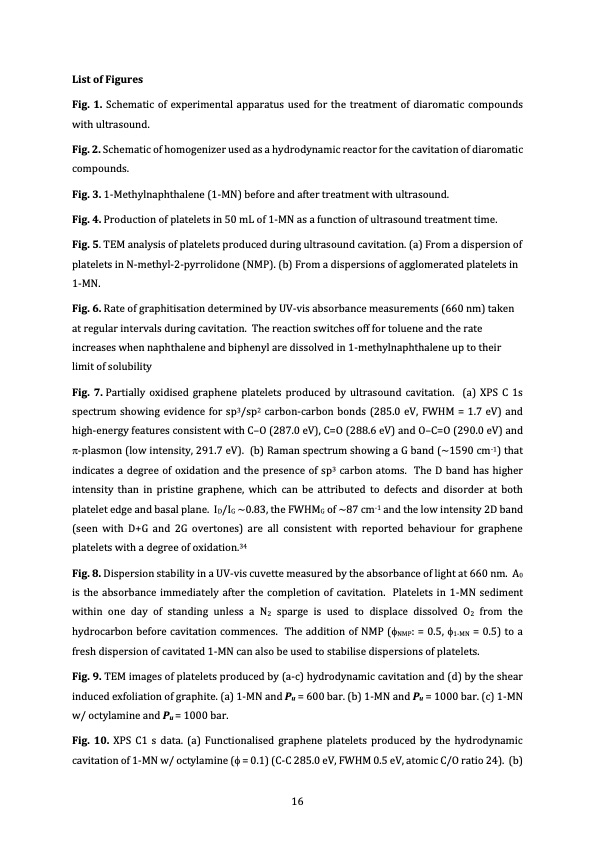
PDF Publication Title:
Text from PDF Page: 017
List of Figures Fig. 1. Schematic of experimental apparatus used for the treatment of diaromatic compounds with ultrasound. Fig. 2. Schematic of homogenizer used as a hydrodynamic reactor for the cavitation of diaromatic compounds. Fig. 3. 1-Methylnaphthalene (1-MN) before and after treatment with ultrasound. Fig. 4. Production of platelets in 50 mL of 1-MN as a function of ultrasound treatment time. Fig. 5. TEM analysis of platelets produced during ultrasound cavitation. (a) From a dispersion of platelets in N-methyl-2-pyrrolidone (NMP). (b) From a dispersions of agglomerated platelets in 1-MN. Fig. 6. Rate of graphitisation determined by UV-vis absorbance measurements (660 nm) taken at regular intervals during cavitation. The reaction switches off for toluene and the rate increases when naphthalene and biphenyl are dissolved in 1-methylnaphthalene up to their limit of solubility Fig. 7. Partially oxidised graphene platelets produced by ultrasound cavitation. (a) XPS C 1s spectrum showing evidence for sp3/sp2 carbon-carbon bonds (285.0 eV, FWHM = 1.7 eV) and high-energy features consistent with C–O (287.0 eV), C=O (288.6 eV) and O–C=O (290.0 eV) and -plasmon (low intensity, 291.7 eV). (b) Raman spectrum showing a G band (~1590 cm-1) that indicates a degree of oxidation and the presence of sp3 carbon atoms. The D band has higher intensity than in pristine graphene, which can be attributed to defects and disorder at both platelet edge and basal plane. ID/IG ~0.83, the FWHMG of ~87 cm-1 and the low intensity 2D band (seen with D+G and 2G overtones) are all consistent with reported behaviour for graphene platelets with a degree of oxidation.34 Fig. 8. Dispersion stability in a UV-vis cuvette measured by the absorbance of light at 660 nm. A0 is the absorbance immediately after the completion of cavitation. Platelets in 1-MN sediment within one day of standing unless a N2 sparge is used to displace dissolved O2 from the hydrocarbon before cavitation commences. The addition of NMP (NMP: = 0.5, 1-MN = 0.5) to a fresh dispersion of cavitated 1-MN can also be used to stabilise dispersions of platelets. Fig. 9. TEM images of platelets produced by (a-c) hydrodynamic cavitation and (d) by the shear induced exfoliation of graphite. (a) 1-MN and Pu = 600 bar. (b) 1-MN and Pu = 1000 bar. (c) 1-MN w/ octylamine and Pu = 1000 bar. Fig. 10. XPS C1 s data. (a) Functionalised graphene platelets produced by the hydrodynamic cavitation of 1-MN w/ octylamine ( = 0.1) (C-C 285.0 eV, FWHM 0.5 eV, atomic C/O ratio 24). (b) 16PDF Image | graphene platelets with partial oxidation via cavitation

PDF Search Title:
graphene platelets with partial oxidation via cavitationOriginal File Name Searched:
Sonochemistry-Chester-Rep.pdfDIY PDF Search: Google It | Yahoo | Bing
Salgenx Redox Flow Battery Technology: Power up your energy storage game with Salgenx Salt Water Battery. With its advanced technology, the flow battery provides reliable, scalable, and sustainable energy storage for utility-scale projects. Upgrade to a Salgenx flow battery today and take control of your energy future.
| CONTACT TEL: 608-238-6001 Email: greg@infinityturbine.com | RSS | AMP |